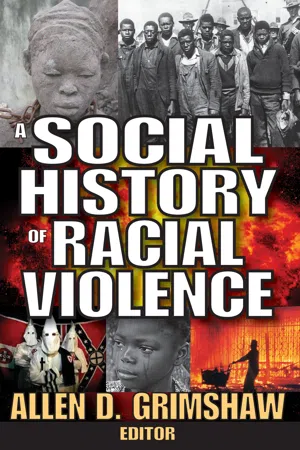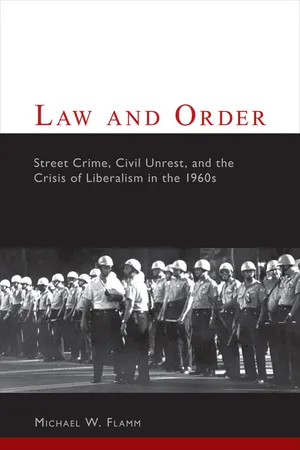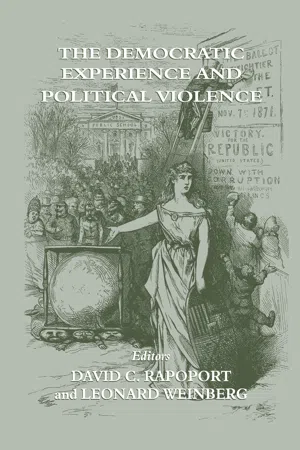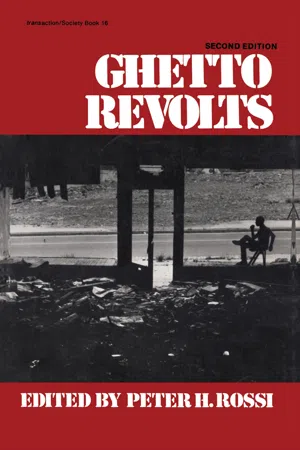History
Detroit Riots
The Detroit Riots, also known as the 12th Street Riot, were a series of violent disturbances that took place in Detroit, Michigan in 1967. The riots were sparked by a police raid on an unlicensed bar and were fueled by long-standing racial tensions and economic inequality. The event resulted in significant property damage, numerous injuries, and deaths, and led to a heightened awareness of civil rights issues in the United States.
Written by Perlego with AI-assistance
Related key terms
4 Key excerpts on "Detroit Riots"
- eBook - ePub
- Allen Grimshaw(Author)
- 2017(Publication Date)
- Routledge(Publisher)
Public transportation provides an opportunity to catch isolated in-dividuals and attack them without fear of immediate reprisal. Anotherscene of violence is government buildings, attacks on which have oc-curred when it is believed that Negroes have sought shelter there orbecause Negroes are known to work there. Negro municipal employeeswere evacuated from the City Hall in Detroit when the building wasthreatened by white mobs. Other locations of interracial violence inmajor northern urban race riots have been highly specific. The riotingin Detroit began on the Belle Isle Bridge and became general apparently only after a much publicized announcement at a Negro night club. Thatlocation (Belle Isle) was on the very periphery of the Negro concentra-tion in Detroit and fits none of the ecological classifications of areassuggested above. Once the riot was under way, activity in the originalarea became minimal.Elmer R. Akers and Vernon Fox *The Detroit Rioters and Looters Committed to Prison
Race riots have occurred many times in the United States, but the conviction and sentence to prison of a hundred and more of the participants is unprecedented in its volume. On March 9, 1944, we had received in the State Prison of Southern Michigan at Jackson 105 of the defendants who had been tried on charges growing out of the Detroit race riot of June 21-22, 1943. Others are still being tried or are awaiting trial.Already there have been written several reams concerning the race riot in Detroit. Newspaper and magazine articles, editorials, pamphlets, surveys of opinion, reports of lawyers’ and other associations, and reports by psychiatrists, police commissions, and various city officials have been published. Probably the most important publication has been a small book by Alfred McClung Lee and Norman D. Humphrey of Wayne University (1943). This volume contains a rather objective journalistic report and sociological interpretation of the riot. - eBook - ePub
Law and Order
Street Crime, Civil Unrest, and the Crisis of Liberalism in the 1960s
- Michael Flamm(Author)
- 2005(Publication Date)
- Columbia University Press(Publisher)
5 .The Politics of Civil UnrestOn July 24, 1967, Detroit was in a state of chaos and the White House was in a state of crisis. One week earlier, the Newark Riot had “put the country near to a psychic flash-point” according to speechwriter Ben Wattenberg, who had joined the staff a year earlier. Now the latest and most serious riot of the decade was escalating out of control.1 Within the administration, officials debated whether Johnson should address the American people in an effort to reassure them. Special Council Harry McPherson opposed the idea since the president would have to assume responsibility for a situation over which he had little or no control. Wattenberg disagreed. “To say that it’s a responsibility without real power to cope with it may be true,” he contended, vision fixed firmly on the 1968 presidential race, “but [it] ignores the fact that Wallace for sure, and probably Nixon and Reagan (and maybe others as well) will ultimately try to stick the blame on the president and the Democrats (as they did in 1964 and 1966)—whether or not any speech is delivered.” Wattenberg was right. The politics of civil unrest was already in full force. That night U.S. Army paratroopers began to patrol the streets of Detroit.2During the “Long Hot Summer” of 1967 more than 100 cities experienced riots. The aftermath revealed the depth of the divide between white and black perceptions of what had happened. A Harris Poll in August showed that although most whites and blacks tended to agree that ghetto residents were the main victims of the riots and that new federal programs would reduce the chance of further unrest, they held starkly different views on what had caused the disorders. Twice as many whites as blacks saw the riots as organized. Twice as many blacks as whites, by contrast, blamed the unrest on discrimination, poor housing, and unemployment. Blacks typically (by a 2–1 margin) cited police brutality as a major factor. Whites overwhelmingly (by an 8–1 margin) rejected it.3 - eBook - ePub
- David C. Rapoport, Leonard Weinberg(Authors)
- 2013(Publication Date)
- Routledge(Publisher)
2 The riots, consequently, are covered in the mystique of one of the great undertakings of revolutionary America. Those who looted and burned their way through Los Angeles, Detroit, Newark, Chicago and lesser places become indistinguishable from those who resisted the BritishCrown and from those who resisted the racial oppression of the deep South by meeting the force of the police truncheon with the dignity of non-violence.The rioters' behaviour was interpreted as a manifestation of an observed clinical phenomenon known as Black rage, a potential for violence born of oppression and discrimination and widely dispersed throughout the Black community.3 White racism caused the riots, in this rendition, and the end of White racism could prevent them in the future. The riots were not a law and order and social control issue, but an issue of appropriate versus inappropriate social policy. The riots were the consequence of persistent and visible racial degradation imposed by White society. The rioters were not criminals but victims in need of understanding.With the imprimatur of both the federal government and distinguished social scientists, these ideas were not received as partisan opinions or speculations, but as conclusions emanating from careful scientific research. If ever there were a social science orthodoxy concerning any phenomenon, this was it, but not only was this the social science orthodoxy of the late 1960s; it would be an orthodoxy renewed with the passage of time and with each eruption of riot behaviour in the Black community.An even stronger consensus was reached concerning what policies should be undertaken to prevent future riots. For while the academic community and most of the members of the commissions held tenaciously to these explanations of the riots as scientific fact, not everyone was in agreement. President Lyndon Baines Johnson found the Kerner Commission report too sweeping in its indictment of American society and refused to accept it, a response that would be pointed to later as responsible for the continuing problems of the inner city. The McCone Commission, which investigated the Los Angeles riots, argued that young, alienated newcomers to Los Angeles were responsible for the riots, and managed by invoking an appeal to the 'riff raff notion of rioters to offend most liberals and members of the Black community.4 - eBook - ePub
- Peter H. Rossi(Author)
- 2019(Publication Date)
- Routledge(Publisher)
By now the guilt or innocence of the culprits, and the manner in which the police treat them, are no longer that central. Instead, the focus is on the crowd members’ general feelings that they live in a world in which they are constantly held accountable to standards of justice which are not applied to others. They feel that the merchants with whom they deal cheat them, that employers are either indifferent or exploiting toward them, that the police are disrespectful and suspicious of them. Therefore, they feel that the police (as representatives of the society at large) are perpetrating the greater evil—an evil by comparison with which the minor peccadillos of the drunken driver, traffic violator, the blind-pig patron are, in human terms, irrelevant.Further, as incidents like this multiply, and as sophistication about Negro victimization rises in the ghetto community, it becomes increasingly possible to generalize this process without a particular incident. Following the news of the Newark, Detroit, and East Harlem riots in July, a group of Negro teenagers went on a rampage after a rock and roll concert, smashing and looting several of New York’s Fifth Avenue stores. They did not need the provocation of an actual encounter with the police to touch off this vivid rejection of legal authority.A riot is a social event which provides different opportunities to different participants. It is a short-lived “opportunity structure.” Of all the aspects of the riot, this is the least well understood. There is no single “rioter,” but rather many kinds of activities, each contributing a little bit to make up the total event. We know almost nothing about who takes each of the possible roles in the rioting—looter, sniper, police attacker, sympathetic bystander, ideological interpreter, and so on. It does seem that the most popular category is that of looter. This makes sense; what the rioters are saying, more than anything else, is “we haven’t gotten our share.” On Detroit’s East and West sides the furniture and appliance stores seemed the hardest hit. “Big ticket” items are the proof of the affluent society and the looters knew exactly where to find them. In this respect the riots become a kind of primitive effort at an income redistribution which the society refuses to support in any lawful and regularized way.
Learn about this page
Index pages curate the most relevant extracts from our library of academic textbooks. They’ve been created using an in-house natural language model (NLM), each adding context and meaning to key research topics.



